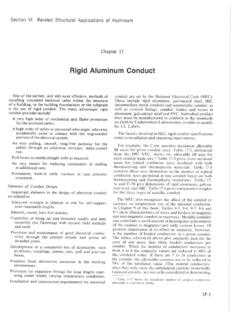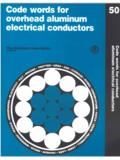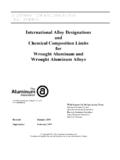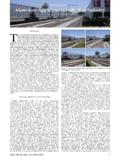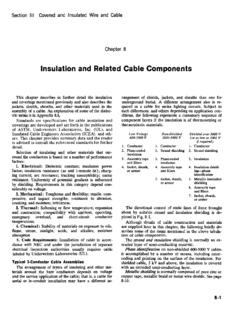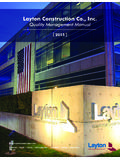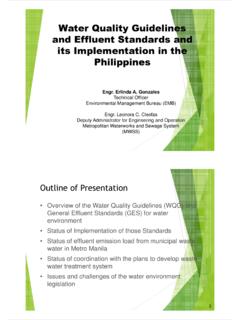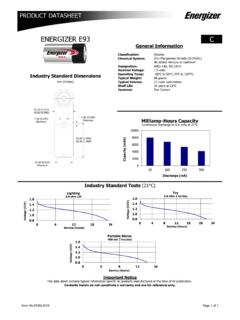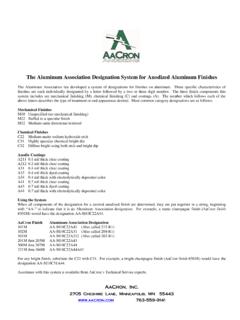Transcription of STANDARD FOR INSTALLING ALUMINUM …
1 AN AMERICAN NATIONAL STANDARD STANDARD FOR INSTALLING ALUMINUM building wire AND CABLENECA/AA 104-20122014A nRecommended Practice forInstalling ALUMINUM BuildingWire and CableNECA/AA 104-2012An AmericanNational STANDARD Published byNational Electrical Contractors AssociationJointly developed withThe ALUMINUM AssociationNOTICE OF COPYRIGHTThis document is copyrighted by NECAR eproduction of these documents either in hard copy or soft (including posting on the web) is prohibited without copyright permission. For copyright permission to reproduce portions of this document, please contact NECA standards & Safety at (301) 657-3110, or send a fax to (301) Electrical Contractors Association 3 Bethesda Metro Center, Suite 1100 Bethesda, Maryland 20814 (301) 657-3110 Organizations may obtain permission to reproduce a limited number of copies by entering into a license agreement.
2 For information, contact:IHS 15 Iverness Way East Englewood, CO 80112-5704 or call 1-800-854-7179 (USA and Canada) (303) 397-7956 (International)i n1. Scope Foreword ..iii1. Scope .. Products and Applications Included .. Products and Applications Excluded .. Regulatory and Other Requirements ..12. Basic Installation Techniques ..2 General .. Stripping Insulation .. Connecting ALUMINUM Conductors .. Pulling ALUMINUM Conductors in Conduits and Raceways .. INSTALLING ALUMINUM Cables in Trays and Racks .. Minimum Bending Radii .. Junction and Pull Boxes ..43. General Product Connector Types .. Joint Compound .. Terminal Lugs .. Connecting ALUMINUM Conductors to Copper Terminal Service Entrances Using ALUMINUM Cables ..13 General .. Residential.
3 135. Designing with ALUMINUM ..14 General .. ALUMINUM Conductor Ampacities and Sizes .. Conduit Fill Requirements .. Voltage Drop Considerations .. Temperature Conditions .. Moisture Conditions ..176. Type AC ALUMINUM Cables ..21 AC Cable Construction .. AC Cable Applications .. AC Cable Terminations .. AC Cable Supports ..22 Table of Contentsn iiNECA/AA 104 STANDARD for INSTALLING ALUMINUM building wire and Fishing AC Cable .. AC Cable Grounding .. AC Cable Ampacities ..237. Type MC Cables ..24 MC Cable Construction .. MC Cable Applications .. MC Cable Fittings .. MC Cable Supports .. MC Cable Grounding .. MC Cable Ampacities .. MC Cable Bending Radius ..26 Annex A: Reference standards ..27 NECA/AA 104 STANDARD for INSTALLING ALUMINUM building wire and Cableiii n1.
4 ScopeNational Electrical Installation standards are designed to improve communication among speci-fiers, purchasers, and suppliers of electrical construc-tion services. They define a minimum baseline of quality and workmanship for INSTALLING electrical products and systems. NEIS are intended to be referenced in contract documents for electrical con-struction projects. The following language is recom-mended: ALUMINUM building wire and cable shall be installed in accordance with NECA/AA 104-2012, STANDARD for INSTALLING ALUMINUM building wire and Cable (ANSI).Use of NEIS is voluntary, and neither the National Electrical Contractors Association nor The ALUMINUM Association assume any obligation or lia-bility to users of this publication. Existence of a stan-dard shall not preclude any member or nonmember of either organization from specifying or using alter-nate construction methods permitted by applicable publication is intended to comply with the edi-tion of the National Electrical Code (NEC) in effect at the time of publication.
5 Because they are quality standards , NEIS may in some cases go beyond the minimum safety requirements of the NEC. It is the responsibility of users of this publication to comply with state and local electrical codes when INSTALLING electrical products and for revisions and improvements to this STANDARD are welcome. They should be addressed to:NECA standards & Safety3 Bethesda Metro Center, Suite 1100 Bethesda, MD 20814(301) 215-4521 telephone(301) 215-4500 purchase NEIS, contact the NECA Order Desk at (301) 215-4504 tel, (301) 215-4500 fax, or NEIS can also be purchased in PDF for-mat from 2012, The ALUMINUM Association and National Electrical Contractors Association. All rights reserved. Unauthorized reproduction Electrical Installation standards , NEIS, and the NEIS logo are trademarks of the National Electrical Contractors Association.
6 National Electrical Code and NEC are registered trademarks of the National Fire Protection illustration courtesy of General Cable (This foreword is not a part of the STANDARD )n iv<This page intentionally left blank>1 n1. ScopeThis STANDARD describes installation procedures and design considerations for ALUMINUM building wire and cable in residential, commercial, institutional and industrial applications not exceeding 2000 volts. Products and Applications IncludedThis publication covers ALUMINUM alloy building wire and cable types USE, USE-2, RHH, RHW, RHW-2, THW, THW-2, THHN, THWN, THWN-2, XHHW and XHHW-2; and AC, MC, TC and Products and Applications ExcludedThis publication does not cover ALUMINUM alloy conductors used in electric utility Regulatory and Other Requirementsa) All information in this publication is intended to comply with the National Electrical Code (NFPA 70).
7 Installers should always follow the NEC, applicable state and local codes, and manufacturers instructions when INSTALLING ALUMINUM building wire and ) Only qualified persons as defined in the NEC who are familiar with the installation of ALUMINUM building wire and cable should perform the work described in this publication. c) Other National Electrical Installation standards provide guidance for INSTALLING additional types of electrical products and systems. A complete list of NEIS is provided in Annex Scopen 21. GeneralInstallation procedures for ALUMINUM alloy building wire products are typical of the procedures required for electrical wire and cable Stripping Insulationa) One way to remove insulation is to pencil or whittle it (Figure 1). Another method is to skin the insulation back from the cut end of the conductor and then cut outward (Figure 2).
8 B) A quicker and easier way is to use one of the several types of insulation strippers that are available to remove insulation. Figure 3 shows a type useful for popular sizes of conductors (6 AWG through 750 kcmil).c) Do not ring cut the insulation from a conductor or cable, using knife or pliers. Doing so can nick or damage the conductors Splicing ALUMINUM ConductorsAluminum conductors should be spliced using connectors as described in Underground connectionsTypically, compression-type connectors are used for underground applications, although screw-type connectors are available for some underground applications. A splice box may or may not be required for these connections. Follow these steps to splice ALUMINUM conductors using compression-type connectors:a) Strip the insulation from the end of each conductor.
9 Strip back far enough so the conductor will go fully into the connector, but also make sure the insulation fits closely to the connector. wire -brush the stripped ) Insert the stripped end of the conductor into the connector as far as it will go. Typically, manufacturers supply these connectors filled with joint compound to seal the splice against moisture and other contaminants. c) Apply the crimping tool designed for that type of connector and crimp fully in accordance with the manufacturer s instructions (Figure 4). Be sure to select the correct crimping tool die for the size of the connector and the conductor being Basic Installation TechniquesFigure 1 Figure 2 Figure 33 nStandard for INSTALLING ALUMINUM building wire and Cable NECA/AA 104d) Wipe off any excess joint compound and insulate the connection using tape, heat or cold-shrinkable tubing or other approved insulating Above-ground connectionsBoth compression-type and screw-type connectors are used for above-ground applications.
10 Compression-type connections are typically made inside electrical equipment or a splice box. Size the box to accommodate the number of conductors and connectors. Follow the instructions in for INSTALLING compression-type connectors. Screw-type connections are typically made inside electrical equipment or junction boxes with built-in terminal strips; these are supplied as an integral part of equipment such as motors and transformers. Install mechanical screw-type terminal lug connectors as described in Install compression-type terminal lug connectors as described in Pulling ALUMINUM Conductors in Conduits and RacewaysFollow these steps to install ALUMINUM conductors in conduits and raceways:a) Be sure that the raceway is sized in accordance with the requirements of the ) Run a fish line through the : Attaching the line to a piston-type device, which is propelled through the conduit by compressed air, can do this.



